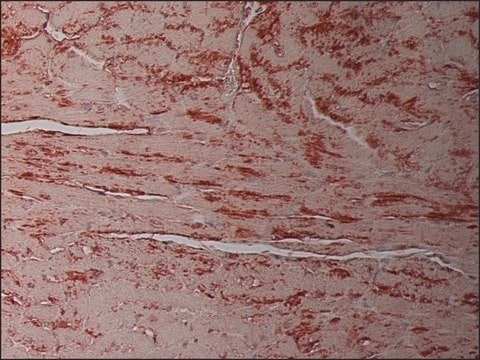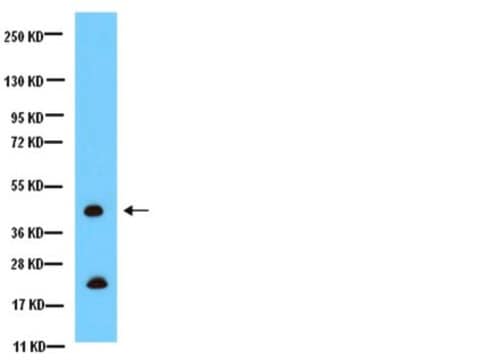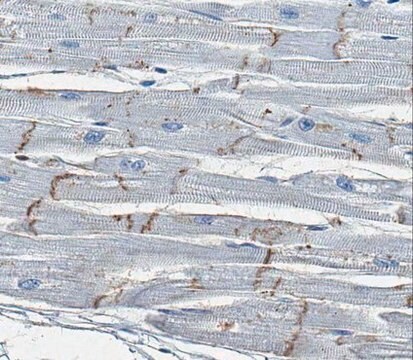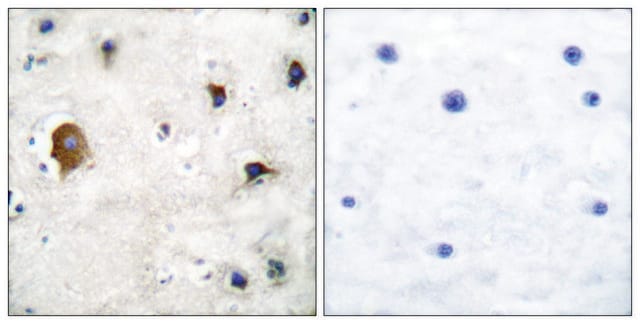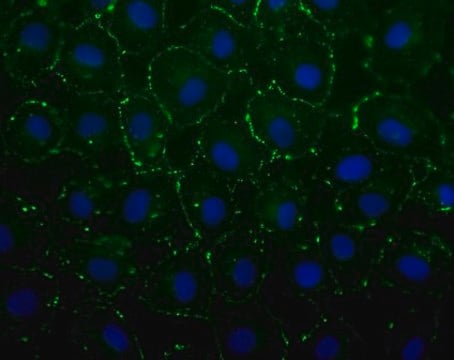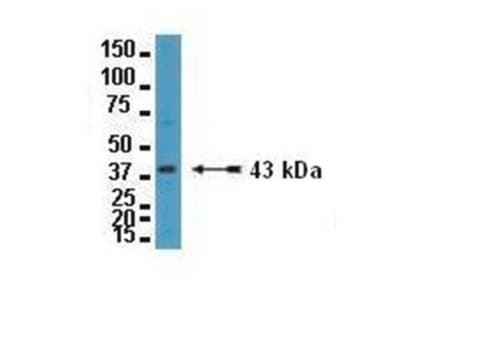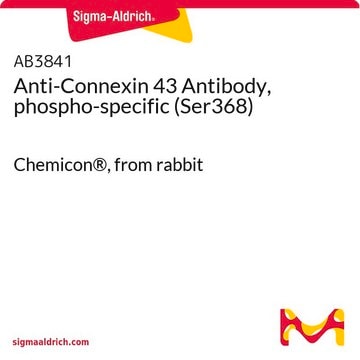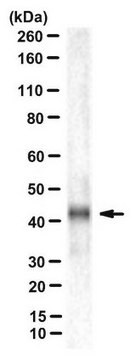C6219
Anti-Connexin-43 antibody produced in rabbit
affinity isolated antibody, buffered aqueous solution
Sinónimos:
Connexin 43 Antibody, Connexin 43 Antibody - Anti-Connexin-43 antibody produced in rabbit, Cx43 Antibody
About This Item
Productos recomendados
origen biológico
rabbit
Nivel de calidad
conjugado
unconjugated
forma del anticuerpo
affinity isolated antibody
tipo de anticuerpo
primary antibodies
clon
polyclonal
formulario
buffered aqueous solution
reactividad de especies
mammals, human
envase
antibody small pack of 25 μL
técnicas
immunocytochemistry: suitable
immunohistochemistry (formalin-fixed, paraffin-embedded sections): 1:2,000 using human or animal tissue sections
immunohistochemistry (frozen sections): 1:2,000 using human or animal tissue sections
indirect immunofluorescence: 1:400 using cultured BHK cells
microarray: suitable
western blot: 1:8,000 using an animal tissue extract
Nº de acceso UniProt
Condiciones de envío
dry ice
temp. de almacenamiento
−20°C
modificación del objetivo postraduccional
unmodified
Información sobre el gen
human ... GJA1(2697)
mouse ... Gja1(14609)
rat ... Gja1(24392)
Descripción general
Gap junctions are specialized cell membrane domains consisting of aggregations of intercellular channels that directly connect the cytoplasm of adjacent cells. Gap junctions coordinate cellular and organ function in tissues and are involved in metabolic cooperation between cells, electrical coupling, synchronization of cellular physiological activities, growth control, and developmental regulation. The gap junction channels allow intercellular exchange of ions, nucleotides and small molecules between adjacent cells. Unlike other membrane channels, intercellular channels span two opposed plasma membranes and require the contribution of hemi-channels, called connexons, from both participating cells. These channels are permeable to molecules as large as 1 kDa, and they have been reported in most mammalian cell types. Two connexons interact in the extracellular space to form the complete intercellular channel. Each connexon is composed of six similar or identical proteins, which have been termed connexins. Connexins (Cx) are a multi-gene family of highly related proteins with molecular weights ranging from 26 to 70 kDa. At least a dozen distinct connexin genes have been identified in mammals, many expressed in a diverse tissue and cell specific pattern. Two distinct lineages have been identified in mammals, one termed class I or β group, in which Cx26, Cx30, Cx31, Cx31.1 and Cx32 fall, and the other termed class II or α group, represented by Cx33, Cx37, Cx40, Cx43 and Cx46.
Connexin-43 (Cx-43), a 43kDa protein, is a member of the connexin protein family that forms a gap junction. It is expressed by a variety of cell types, such as astrocytes, cardiac and smooth muscle, endothelium, ependyma, fibroblasts, keratinocytes, lens and corneal epithelium. In addition, the protein is also found in leptomeninges, leucocytes, Leydig cells, macrophages, myoepithelial cells of mammary gland, osteocytes, ovarian granulosa, pancreatic β-cells, preimplantation blastocyst, sertoli cells, thyroid follicular cells and trophoblast giant cells.
Especificidad
Inmunógeno
Aplicación
A minimum working dilution of 1:8,000 is determined by immunoblotting using a whole extract from mouse brain.
A minimum working dilution of 1:400 is determined by indirect immunofluorescent staining of acetone-fixed cultured baby hamster kidney (BHK).
A minimum working dilution of 1:2,000 is determined by indirect immunofluorescent staining of rat heart. (Negative on rat liver sections)
A minimum working dilution of 1:2,000 is determined by indirect immunoperoxidase staining of trypsin-digested,formalin-fixed, paraffin-embedded human or animal tissue.
Acciones bioquímicas o fisiológicas
Forma física
Almacenamiento y estabilidad
Cláusula de descargo de responsabilidad
Not finding the right product?
Try our Herramienta de selección de productos.
Opcional
Código de clase de almacenamiento
12 - Non Combustible Liquids
Clase de riesgo para el agua (WGK)
nwg
Punto de inflamabilidad (°F)
Not applicable
Punto de inflamabilidad (°C)
Not applicable
Certificados de análisis (COA)
Busque Certificados de análisis (COA) introduciendo el número de lote del producto. Los números de lote se encuentran en la etiqueta del producto después de las palabras «Lot» o «Batch»
¿Ya tiene este producto?
Encuentre la documentación para los productos que ha comprado recientemente en la Biblioteca de documentos.
Los clientes también vieron
Artículos
Cancer research has revealed that the classical model of carcinogenesis, a three step process consisting of initiation, promotion, and progression, is not complete.
Nuestro equipo de científicos tiene experiencia en todas las áreas de investigación: Ciencias de la vida, Ciencia de los materiales, Síntesis química, Cromatografía, Analítica y muchas otras.
Póngase en contacto con el Servicio técnico

